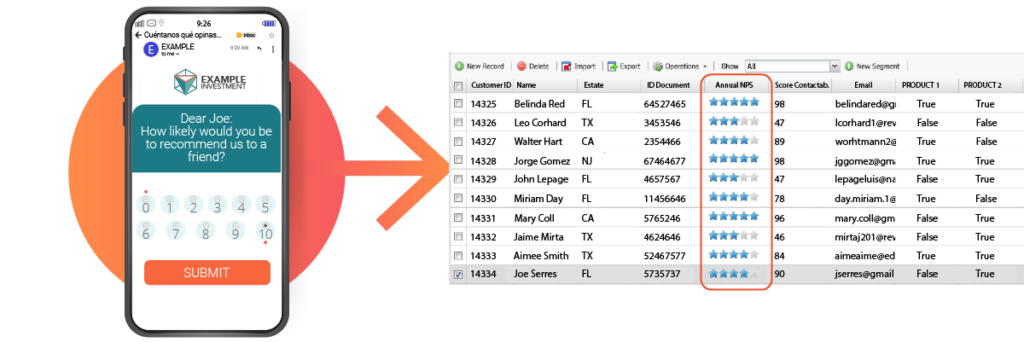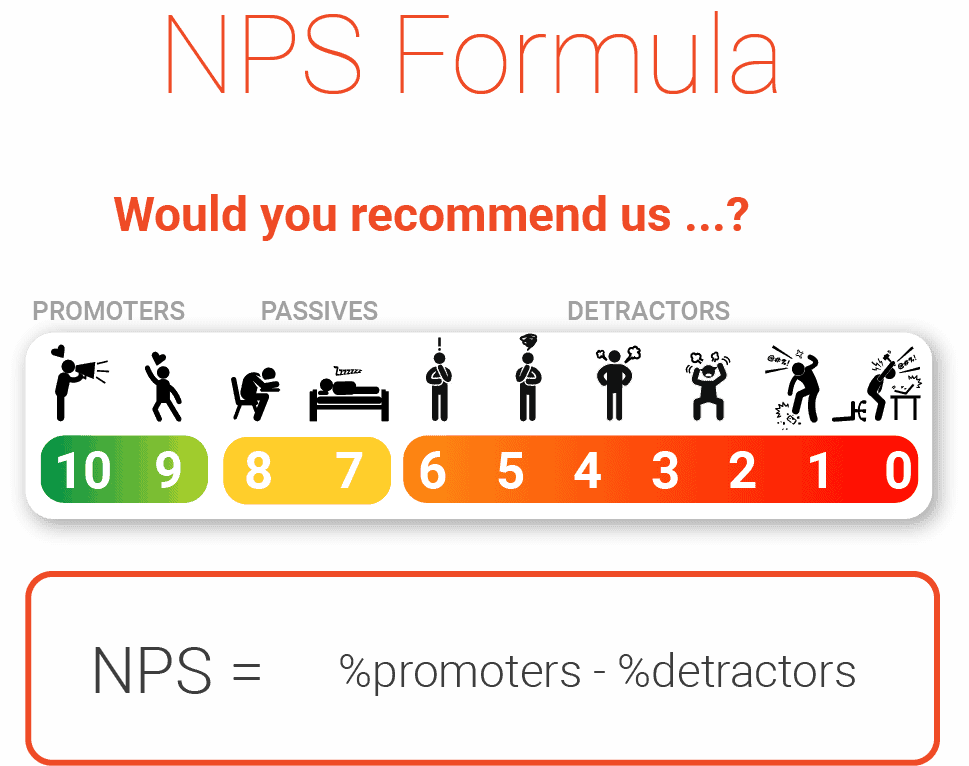Annual NPS Measurement – Net Promoter Score

What is Annual NPS Measurement?
The Annual Net Promoter Score allows the company to gauge customer loyalty by sending a survey to customers, either by email or text message, asking the single question “Would you recommend us to your friends?”. Depending on the customer’s opinion, a next action is automatically scheduled, some time later, that is related to the response he gave to strengthen the relationship, showing the commitment to find resolution and following up.
Want to see a demo of this solution?
Objectives:
- Obtain a benchmark of customer loyalty for the company.
- Segment the “Detractors” to be able to take appropriate follow-up actions and improve perception.
- Obtain information directly from the customer that provides the reasons for their opinion.
- Segment the “Promoters” for use with a follow-up combining a referral program.
- Segment the “Passives” to offer some promotion and push the brand image from neutral to positive.
Solution:
Automation campaign to measure customer loyalty using the NPS methodology. Depending on the score obtained, clients are classified as promoters, detractors and passives. After classification, this information is used to segment and make new follow-up shipments with different and personalized communications for the three types of customers.
Customization options:
- Follow-up actions depending on the needs of the organization.
- Configurable corporate image, colors, logo and graphics in the messages.
- Integration with CRM, helpdesk, core or other systems of the organization.
- Combination of cross-channel channels according to needs: web portal, email, SMS, mobile application, automated call or any other digital channel that the organization has available.
Implementation timeframe:
- 2 to 4 weeks
Pre-requirements:
- DANAconnect Advanced
Want to see a demo of this solution?
Frequent Asked Questions about Net Promoter Score NPS?
What is NPS?
The Net Promoter Score (NPS) is the world’s leading customer loyalty and satisfaction metric. NPS measures customers’ likelihood to recommend a company’s products or services to others on a scale of 0-10. NPS surveys are typically one-question polls that ask respondents how likely they are to recommend a company’s products or services on a scale of 0-10, with 10 being the most likely. NPS scores can range from -100 to 100, with scores above 0 considered to be good and scores below 0 considered to be bad.
How NPS scores calculated?
NPS scores are calculated by subtracting the percentage of detractors from the percentage of promoters. For example, if a company has an NPS score of 50, that means that 50% of respondents are promoters and 50% are detractors. NPS scores can be positive or negative but are typically expressed as a positive number.
How do companies use NPS?
NPS scores are used by companies to measure customer satisfaction and loyalty. NPS can also be used to track changes in customer satisfaction over time. In addition, NPS is considered a leading indicator of growth, as companies with high NPS scores tend to grow faster than those with low NPS scores.
Can NPS scores be negative?
NPS scores can be positive or negative but are typically expressed as a positive number. For example, a score of 0 would mean equal numbers of promoters and detractors. In contrast, a score of 100 would mean that all respondents are promoters.
Who created NPS?
It was developed by Fred Reichheld, Bain & Company, and Satmetrix. NPS measures customers’ likelihood to recommend a company’s products or services to others on a scale of 0-10. NPS surveys are typically one-question polls that ask respondents how likely they are to recommend a company’s products or services on a scale of 0-10, with 10 being the most likely. N PS scores can range from -100 to 100, with scores above 0 considered to be good and scores below 0 considered to be bad.
What are the benefits of NPS?
There are many benefits to measuring NPS, including:
– gaining insights into customer satisfaction levels
– identifying loyal and advocate customers
– pinpointing areas for improvement.
What are some best practices for conducting an NPS survey?
When conducting an NPS survey, there are a few best practices to keep in mind, including:
– sending the survey to a representative sample of your customer base.- making it easy for customers to respond with only one clic.
– following up with customers who leave negative feedback.
– using the promoters score to create segments for referral programs.
By following these best practices, you can ensure that you take all the advantages of a NPS survey.
What factors affect NPS?
The factors that affect NPS can be divided into three categories: product factors, service factors, and brand factors.
Product factors include the quality of the product itself as well as factors such as price and features. Likewise, service factors include the quality of customer service and the ease of use of the product or service. Finally, brand factors include factors such as reputation and name recognition. All these factors can affect how likely a customer is to recommend a product or service to others. Therefore, to improve NPS, it is essential to identify which factors are affecting it negatively and take steps to improve them.
How to improve NPS?
To improve NPS, businesses need to first identify the root cause of customer dissatisfaction. This can be done through surveys, interviews, and focus groups. Once the problem has been identified, businesses can put in place solutions to address the issue. This may involve making changes to the product or service itself, improving customer service, or making it easier for customers to give feedback. By taking these steps, businesses can improve NPS and better meet the needs of their customers.

